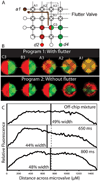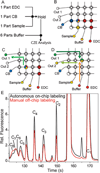Digitally programmable microfluidic automaton for multiscale combinatorial mixing and sample processing
- PMID: 23172232
- PMCID: PMC3568922
- DOI: 10.1039/c2lc40861a
Digitally programmable microfluidic automaton for multiscale combinatorial mixing and sample processing
Abstract
A digitally programmable microfluidic Automaton consisting of a 2-dimensional array of pneumatically actuated microvalves is programmed to perform new multiscale mixing and sample processing operations. Large (μL-scale) volume processing operations are enabled by precise metering of multiple reagents within individual nL-scale valves followed by serial repetitive transfer to programmed locations in the array. A novel process exploiting new combining valve concepts is developed for continuous rapid and complete mixing of reagents in less than 800 ms. Mixing, transfer, storage, and rinsing operations are implemented combinatorially to achieve complex assay automation protocols. The practical utility of this technology is demonstrated by performing automated serial dilution for quantitative analysis as well as the first demonstration of on-chip fluorescent derivatization of biomarker targets (carboxylic acids) for microchip capillary electrophoresis on the Mars Organic Analyzer. A language is developed to describe how unit operations are combined to form a microfluidic program. Finally, this technology is used to develop a novel microfluidic 6-sample processor for combinatorial mixing of large sets (>2(6) unique combinations) of reagents. The digitally programmable microfluidic Automaton is a versatile programmable sample processor for a wide range of process volumes, for multiple samples, and for different types of analyses.
Figures







Similar articles
-
Universal microfluidic automaton for autonomous sample processing: application to the Mars Organic Analyzer.Anal Chem. 2013 Aug 20;85(16):7682-8. doi: 10.1021/ac303767m. Epub 2013 Jul 29. Anal Chem. 2013. PMID: 23675832
-
A digital microfluidic platform for the automation of quantitative biomolecular assays.Lab Chip. 2010 Mar 21;10(6):685-91. doi: 10.1039/b920124f. Epub 2009 Dec 23. Lab Chip. 2010. PMID: 20221555
-
Pneumatically actuated microvalve circuits for programmable automation of chemical and biochemical analysis.Lab Chip. 2016 Mar 7;16(5):812-9. doi: 10.1039/c5lc01397f. Lab Chip. 2016. PMID: 26864083 Review.
-
A software-programmable microfluidic device for automated biology.Lab Chip. 2011 May 7;11(9):1612-9. doi: 10.1039/c0lc00537a. Epub 2011 Mar 17. Lab Chip. 2011. PMID: 21416077
-
Microfluidic platforms for lab-on-a-chip applications.Lab Chip. 2007 Sep;7(9):1094-110. doi: 10.1039/b706364b. Epub 2007 Jul 27. Lab Chip. 2007. PMID: 17713606 Review.
Cited by
-
Normally closed plunger-membrane microvalve self-actuated electrically using a shape memory alloy wire.Microfluid Nanofluidics. 2018 Mar;22:29. Epub 2018 Feb 21. Microfluid Nanofluidics. 2018. PMID: 30555287 Free PMC article.
-
A novel wide-range microfluidic dilution device for drug screening.Biomicrofluidics. 2019 Mar 22;13(2):024105. doi: 10.1063/1.5085865. eCollection 2019 Mar. Biomicrofluidics. 2019. PMID: 30931077 Free PMC article.
-
Automated long-term monitoring of parallel microfluidic operations applying a machine vision-assisted positioning method.ScientificWorldJournal. 2014;2014:608184. doi: 10.1155/2014/608184. Epub 2014 Jul 15. ScientificWorldJournal. 2014. PMID: 25133248 Free PMC article.
-
Microvalve array fabrication using selective PDMS (polydimethylsiloxane) bonding through Perfluorooctyl-trichlorosilane passivation for long-term space exploration.Sci Rep. 2022 Jul 20;12(1):12398. doi: 10.1038/s41598-022-16574-9. Sci Rep. 2022. PMID: 35858972 Free PMC article.
-
Reconfigurable microfluidic dilution for high-throughput quantitative assays.Lab Chip. 2015 Jun 21;15(12):2670-9. doi: 10.1039/c5lc00432b. Lab Chip. 2015. PMID: 25994379 Free PMC article.
References
Publication types
MeSH terms
Substances
Grants and funding
LinkOut - more resources
Full Text Sources
Other Literature Sources
Miscellaneous

